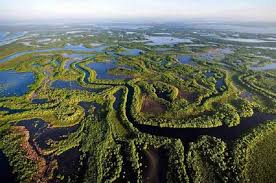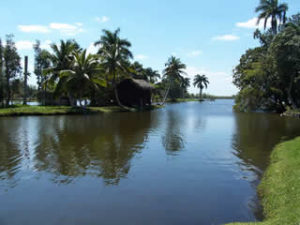 LA CIENAGA DE ZAPATA, EL HUMEDAL Y MAS ASOMBROSO ECOSISTEMA DE LA FAUNA CUBANA.
LA CIENAGA DE ZAPATA, EL HUMEDAL Y MAS ASOMBROSO ECOSISTEMA DE LA FAUNA CUBANA.
Un asombroso y destacado pedazo de nuestra patria es “La Ciénaga de Zapata” uno de los mayores humedales de América Latina y también el municipio más extenso de Cuba y de menor densidad poblacional. Este pedazo enamora y esconde en cada piedra y cada trozo de tierra, un misterio.
En la Ciénaga de Zapata predominan los bosques sobre calizas y partes mal drenadas, así como los manglares. Además, existen grandes extensiones generalmente inundables donde crece el herbazal de ciénaga, formado por Cortadera, Palmanaca, Arraiján, Yana y Guanito, entre otras.
El patrimonio forestal de la Ciénaga de Zapata esta constituido por: bosques naturales (233 265.3 ha), plantaciones jóvenes (928.2 ha) y plantaciones establecidas (4 170.8 ha). Según The Field Museum 2005 se estima que existen alrededor de 1000 especies de plantas autóctonas agrupadas en 110 familias, destacándose 130 endémicas cubanas, de las cuales 6 son locales y 14 son especies raras o en peligro de extinción (Amorín, J, et al 2002).
La fauna está representada por 15 especies de Mamíferos, 258 de Aves, 43 de Reptiles, 4 de Peces y 16 de Anfibios, así como una gran variedad de Insectos y otros Invertebrados. Entre las especies de animales se destacan 5 endémicas locales y 16 en peligro de extinción. Esta región es además uno de los refugios más importantes de 65 especies de aves migratorias.
Respecto a los animales, los valores del lugar trascienden las fronteras locales, la Gallinuela de Santo Tomás y la Ferminia son aves exclusivas de la zona y consideradas como las de hábitat más restringido en el mundo.
De conjunto, se han observado más de cien especies de Aves endémicas de Cuba, entre ellas el Zunzuncito, Cabrerito de la Ciénaga, Gavilán colilargo, Catey, Cotorra y Paloma Perdiz, de las que se forman grandes concentraciones durante todo el año. La Ciénaga de Zapata constituye refugio natural de miles de aves migratorias provenientes de América del Norte.
Existen dieciséis especies de reptiles, entre los que sobresalen los Cocodrilos cubano y americano, Iguana, Lagartijas, Majaes y varios tipos de Ranas.
Los mamíferos están representados por un endémico local: la Jutía enana, además de la Jutía conga, así como por abundantes poblaciones introducidas de Puerco jíbaro y Venados.
En los esteros y lagunas es posible localizar dos especies de vertebrados acuáticos amenazados de extinción: el Manatí y el Manjuarí, este último es un pez que en Cuba sólo se encuentra en esa región.
Hasta ahora, en la Ciénaga de Zapata se han podido identificar más de mil especies de insectos, Arácnidos y Artrópodos, algunos de formas muy peculiares. Como en todas las ciénagas de la isla, abundan allí varias especies de Mosquitos y Jejenes.
Para aumentar el atractivo de la Ciénaga de Zapata, se encuentran allí cavernas muy profundas cerca de la costa sur, en las que las aguas varían desde dulces arriba hasta totalmente saladas en las profundidades.
Viven en ellas varios representantes de la fauna marina, incluyendo corales y peces. La zona constituye un ecosistema húmedo o tierras muy humedecidas que hoy son objeto de gran interés para la protección ambiental, pues la Ciénaga de Zapata y otras costeras de Cuba constituyen verdaderos laboratorios naturales. Un ecosistema muy saludable en este entorno cubano es el de los flamencos.
Gran parte del Parque Nacional Ciénaga de Zapata está cubierto de bosques exóticos, ríos, lagos, cavernas inundadas, piscinas naturales, zonas vírgenes y sabanas típicas de ciénaga que brinda refugio al 30 por ciento de la fauna autóctona de Las Antillas Mayores.
 LA CIENAGA DE ZAPATA, THE HUMEDAL AND MOST AMAZING ECOSYSTEM OF THE CUBAN FAUNA.
LA CIENAGA DE ZAPATA, THE HUMEDAL AND MOST AMAZING ECOSYSTEM OF THE CUBAN FAUNA.
An astonishing piece of our homeland is “La Ciénaga de Zapata” which is one of the largest wetlands in Latin America and also the largest municipality in Cuba and of lower population density. This piece falls in love and hides in each stone and each piece of land, a mystery.
In the Ciénaga de Zapata, forests predominate over limestones and poorly drained parts, as well as mangroves. In addition, there are large areas usually flooded where swamp grassland grows, formed by Cortadera, Palmanaca, Arraiján, Yana and Guanito, among others.
The forest heritage of the Ciénaga de Zapata is constituted by natural forests (233 265.3 ha), young plantations (928.2 ha) and established plantations (4 170.8 ha). According to The Field Museum 2005, it is estimated that there are about 1000 species of native plants grouped into 110 families, with 130 Cuban endemics standing out, of which 6 are local and 14 are rare or endangered species (Amorín, J, et al 2002 ).
The fauna is represented by 15 species of Mammals, 258 of Birds, 43 of Reptiles, 4 of Fish and 16 of Amphibians, as well as a great variety of Insects and other Invertebrates. Among the animal species, 5 local endemics and 16 endangered species stand out. This region is also one of the most important shelters of 65 species of migratory birds.
Regarding the animals, the values of the place transcend the local borders, the Gallinuela de Santo Tomás and the Ferminia are exclusive birds of the area and considered as the most restricted habitat in the world.
Overall, more than one hundred species of birds endemic to Cuba have been observed, among them the Zunzuncito, Cabrerito de la Ciénaga, Gavilán colilargo, Catey, Cotorra and Paloma Perdiz, of which large concentrations are formed throughout the year. The Ciénaga de Zapata is a natural refuge for thousands of migratory birds from North America.
There are sixteen species of reptiles, among which the Cuban and American Crocodiles, Iguana, Lizards, Majaes and various types of Frogs stand out.
Mammals are represented by a local endemic: the Dwarf Jutía, in addition to the Jutía conga, as well as abundant introduced populations of Pork jíbaro and Venados.
In the estuaries and lagoons it is possible to locate two species of aquatic vertebrates threatened with extinction: the Manati and the Manjuarí, the latter is a fish that is only found in Cuba in that region.
So far, in the Ciénaga de Zapata, more than a thousand species of insects, Arachnids and Arthropods, some of the very peculiar forms have been identified. As in all the marshes of the island, several species of Mosquitos and Jejenes abound there.
To increase the attractiveness of the Ciénaga de Zapata, there are very deep caverns near the south coast, in which the waters vary from sweet up to totally salty in the depths.
They live in them several representatives of the marine fauna, including corals and fish. The area constitutes a humid ecosystem or very humidified lands that today are of great interest for environmental protection since the Ciénaga de Zapata and other coastal ones in Cuba constitute true natural laboratories. A very healthy ecosystem in this Cuban environment is that of flamingos.
Much of the Ciénaga de Zapata National Park is covered with exotic forests, rivers, lakes, flooded caverns, natural pools, virgin areas and typical swamp savannas that provide shelter to 30 percent of the native fauna of the Greater Antilles.
Agencies/ TodoCuba/ Internet Photos/ Arnoldo Varona/ www.TheCubanHistory.com
THE CUBAN HISTORY, HOLLYWOOD.



















